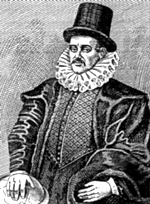|
There followed more than a century of attempts to study and understand these elusive phenomena. Only after 1958, when the first scientific spacecraft were launched and when Explorers 1 and 3 discovered the radiation belt, did scientists fully appreciate the complexity of electric and magnetic phenomena that occur in the Earth's magnetic environment.
In 1959 Thomas Gold of Cornell University proposed to name that environment "magnetosphere", and this name is still used.
Further reading:
- look up in an encyclopaedia "magnetosphere", "Gilbert, William Gilbert", "Humboldt, Alexander von".
- William Gilberts book "De Magnete" ("On the Magnet"), originally in Latin, is available in two English translations one of them (by Dover books) still in print. See
- Historical details and many references can be found in "A Brief History of Magnetospheric Physics Before the Spaceflight Era" by David P. Stern, Reviews of Geophysics, 27, 103-114, 1989.
|
 William Gilbert
William Gilbert  Official GSFC Home Page
Official GSFC Home Page  NASA WWW Home Page
NASA WWW Home Page